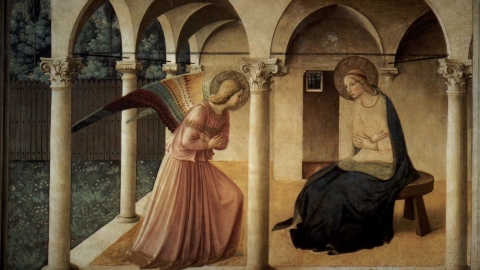A New Translation of the Missal (1)

The March 2021 Letter to Our Brother Priests, no. 89, a quarterly liaison letter of the Society of Saint Pius X with the clergy of France, has published a very interesting article on the translation of the new missal into French. The Letter is being published by FSSPX.News in three parts.
Starting in 2002, a new translation of the Missal of Paul VI was scheduled to appear. La Croix, on May 26, 2016, announced it was supposed to be implemented on either the first Sunday of Lent, or on the first Sunday of Advent in 2017. The same article pointed out that a first version of the translation was refused by Rome in 2007. It therefore took almost 20 years to finally arrive at a new French edition of this version of the Missal.
We intervene here as external observers, in a sense, since, for our part, we celebrate the traditional liturgy exclusively, and never the liturgy of Paul VI, and this for solid reasons. However, this episode regarding the translation of the Missal of Paul VI seems interesting to us as a means to better understand the current developments of the Church, and the liturgy which is celebrated there.
Reasons for the Delay
There are some purely practical reasons that partly explain this long delay. There exist three main ones.
The first reason is that the whole francophone area is involved, with different language habits: such and such an expression can have one meaning in France, a more or less different meaning in Belgium, another meaning in Quebec, etc. The second reason is that each episcopal conference of each French-speaking country must validate both the intermediate version and the final result, which guarantees a very long process. Such was seen in 2004 during the vote on the European Constitution, where 25 different countries had to validate the treaty, which did not happen (France and the Netherlands having voted against it). The third reason is that the episcopal conferences dealing with the various versions of the text are changed by the arrival of new bishops approximately every three years. So, for example, in France, when the text is submitted to the bishops for examination, about 20 new bishops (a figure from La Croix of May 25, 2016) must read the entirety of this complex dossier, which does not facilitate rapid decision-making.
A Behind-the-Scences Battle
But these three reasons, and perhaps others which could be brought in as practical contributions, are by no means the ultimate explanation for such an impressive delay. In fact, a hushed yet fierce battle has unfolded behind the scenes over the past two decades. It opposes the Congregation of Divine Worship and the leading nucleus of the French episcopate.
The reality of this war is manifested by the almost simultaneous publication of two presentations of the new translation. The ruling nucleus of the French episcopate fired first, trying to preempt the debate and turn it to its advantage. In November 2019, it published through Desclée Mame, a book entitled Discover the New Translation of the Roman Missal, where it seems that nothing has changed or should change. But Cardinal Sarah, then Prefect of the Congregation for Divine Worship was determined to not let himself be trodden on. He published on June 5, 2020, through Artège, a book titled Presentation of the New Roman Missal in French, which clearly shows what has changed, and why it had to change.
The Heart of the Dispute
At the start of the conflict, the fifth post-Conciliar “Instruction for the Right Application of the Constitution on the Sacred Liturgy” of the Second Vatican Council, was published on March 28, 2001 under the title Liturgiam authenticam. This fairly detailed instruction deals exclusively with the question of translating the original text into the various vernacular languages. It gives both the principles of translation and the legal rules for the preparation and promulgation of a translation. The principles of translation are distinguished depending on what text is being considered, for example, the Bible, Eucharistic Prayers, the Creed, rubrics, etc.
This provision has long blocked attempts to revolutionize the text: “The Latin liturgical texts of the Roman Rite, while drawing on centuries of ecclesial experience in transmitting the faith of the Church received from the Fathers, are themselves the fruit of the liturgical renewal, just recently brought forth. In order that such a rich patrimony may be preserved and passed on through the centuries, it is to be kept in mind from the beginning that the translation of the liturgical texts of the Roman Liturgy is not so much a work of creative innovation as it is of rendering the original texts faithfully and accurately into the vernacular language. While it is permissible to arrange the wording, the syntax, and the style in such a way as to prepare a flowing vernacular text suitable to the rhythm of popular prayer, the original text, insofar as possible, must be translated integrally and in the most exact manner, without omissions or additions in terms of their content, and without paraphrases or glosses. Any adaptation to the characteristics or the nature of the various vernacular languages is to be sober and discreet” (No. 20).
However, since the 1960s, the French often opted for expressions which are glosses and formulas foreign to the normative Latin text. The French remain reluctant to return to a more literal translation of liturgical texts, despite Rome’s instructions. They therefore led a permanent guerrilla war to maintain the status quo, drag their feet, and offer again a text (even in a slightly modified form) which Rome already refused.
This is obviously not a question of making “literalism” contrary to the genius of the French language. And this is by no means what Liturgiam authenticam instruction requires. Of course, Latin words must be rendered by French words, Latin sentences must be rendered by French sentences while respecting French syntax, French grammar, the spirit of the French language. But nevertheless, in the end, the French translation must convey the content of the original Latin text, and not substitute glosses or new formulas for it.
The Orate Fratres Example
An immediately obvious example of the French episcopate's approach in the 1960s is that of the Orate fratres. The roughly literal translation would be: “Pray, my brethren, that my sacrifice, which is also yours, will be acceptable to God the Father Almighty. May the Lord receive from your hands this sacrifice for the praise and glory of His Name, for our good and that of all His holy Church.” The French formula, chosen for more than half a century, departs sharply from it, losing in the process a great wealth of meaning: “Let us pray together at the time of offering the sacrifice of the whole Church, for the glory of God and the salvation of the world.”
However, the formula “my sacrifice which is also yours” is perfectly French; and the formula “the sacrifice of the whole Church” is by no means equivalent to it. We are not saying, moreover, that the formula “the sacrifice of the whole Church” is not a beautiful formula: we are simply saying that it is not the formula of the Roman Missal. It is an invention. And we say again that the formula of the Roman Missal “my sacrifice which is also yours” possesses a great richness, and that there is no reason to lose it and make it disappear in favor of another formula.
Likewise, the outright erasure of the phrase “be acceptable to God the Father Almighty” is a loss that is not justified by any serious linguistic and cultural reason. It is the same with the deletion of the word “sacrifice” in the response of the faithful, as well as the unnecessary and unjustified transformation of the formula “for the praise and the glory of His Name, for our good and that of all His holy Church” in this fanciful and invented whole cloth formula: “For the glory of God and the salvation of the world.”
(Source : Lettre à nos frères prêtres – FSSPX.Actualités)



